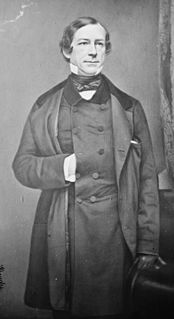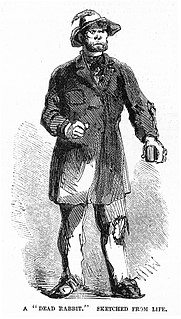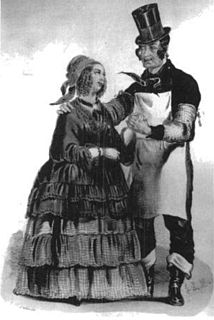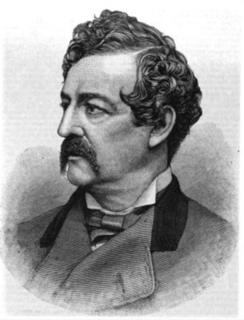Related Research Articles

Five Points was a 19th-century neighborhood in Lower Manhattan, New York City. The neighborhood, partly built on land which had filled in the freshwater lake known as the Collect Pond, was generally defined as being bound by Centre Street to the west, the Bowery to the east, Canal Street to the north, and Park Row to the south. The Five Points gained international notoriety as a densely populated, disease-ridden, crime-infested slum that existed for over 70 years.
A gangster is a criminal who is a member of a gang. Some gangs are considered to be part of organized crime. Gangsters are also called mobsters, a term derived from mob and the suffix -ster. Gangs provide a level of organization and resources that support much larger and more complex criminal transactions than an individual criminal could achieve. Gangsters have been active for many years in countries around the world. Gangsters are the subject of many novels, films, and video games.

Fernando Wood was an American politician of the Democratic Party and the 73rd and 75th mayor of New York City; he also served as a United States Representative and as Chairman of the Committee on Ways and Means in both the 45th and 46th Congress (1877–1881).

The Dead Rabbits was the name of an Irish American criminal street gang active in Lower Manhattan in the 1830s to 1850s. The Dead Rabbits were so named after a dead rabbit was thrown into the center of the room during a gang meeting, prompting some members to treat this as an omen, withdraw, and form an independent gang. Their battle symbol was a dead rabbit on a pike. They often clashed with Nativist political groups who viewed Irish Catholics as a threatening and criminal subculture. The Dead Rabbits were given the nicknames the "Mulberry Boys" and the "Mulberry Street Boys" by the New York City Police Department because they were known to have operated along Mulberry Street in the Five Points.

John Donato Torrio was an Italian-American mobster who helped build the Chicago Outfit in the 1920s. It was later inherited by his protégé Al Capone. Torrio proposed a National Crime Syndicate in the 1930s and later became an adviser to Lucky Luciano and his Luciano crime family.
Herbert Asbury was an American journalist and writer best known for his books detailing crime during the 19th and early-20th centuries, such as Gem of the Prairie: An Informal History of the Chicago Underworld, The Barbary Coast: An Informal History of the San Francisco Underworld, Sucker's Progress: An Informal History of Gambling in America and The Gangs of New York.

B'hoy and g'hal were the prevailing slang words used to describe the young men and women of the rough-and-tumble working class culture of Lower Manhattan in the late 1840s and into the period of the American Civil War. They spoke a slang, with phrases such as "hi-hi", "lam him", and "cheese it".

The New Yorker vernacular pronunciation of Bowery Boys was Bowery B’hoys referring to working-class single men living mostly along the Bowery in New York City in the early 19th century. Notorious for their rowdy behavior and bright clothes, these men participated actively in theatre audiences during their time away from work and their living wards.

Francis S. Chanfrau was an American actor and theatre manager in the 19th century. He began his career playing bit parts and doing impressions of star actors such as Edwin Forrest and of ethnic groups.

Jewish-American organized crime initially emerged within the American Jewish community during the late 19th and early 20th centuries. It has been referred to variously in media and popular culture as the Jewish Mob, Jewish Mafia, Kosher Mob, Kosher Mafia, and Kosher Nostra or Undzer Shtik. The last two of these terms are direct references to the Italian Cosa Nostra; the former is a play on the word kosher, referring to Jewish dietary laws, while the latter is a direct translation of the Italian phrase Cosa Nostra into Yiddish, which was at the time the predominant language of the Jewish diaspora in the United States.
Samuel Jules "Nails" Morton was a soldier during World War I and later a high-ranking member of Dean O'Banion's Northside gang.

The Bowery Boys were a nativist, anti-Catholic, and anti-Irish criminal gang based in the Bowery neighborhood of Manhattan, New York City in the early-mid-19th century. In contrast with the Irish immigrant tenement of the Five Points, one of the worst city slums in the United States, the Bowery was a more prosperous working-class community. Despite its reputation as one of the most notorious street gangs of New York City at the time, the majority of the Bowery Boys led law-abiding lives for the most part. The gang was made up exclusively of volunteer firemen—though some also worked as tradesmen, mechanics, and butchers —and would fight rival fire companies over who would extinguish a fire. The Bowery Boys often battled multiple outfits of the infamous Five Points, most notably the Dead Rabbits, with whom they feuded for decades. The uniform of a Bowery Boy generally consisted of a stovepipe hat in variable condition, a red shirt, and dark trousers tucked into boots—this style paying homage to their firemen roots.

Gangs in the United States include several types of groups, including national street gangs, local street gangs, prison gangs, motorcycle clubs, and ethnic and organized crime gangs. Approximately 1.4 million people were part of gangs as of 2011, and more than 33,000 gangs were active in the United States.
George "Country McCloskey" McCheester or John McCleester was an American bare-knuckle boxer and sportsman involved in the early history of pugilism and prize fighting in Old New York. A contender for the American heavyweight championship in 1849, he was an enforcer for the Irish Tammany Hall politicians, and a member of Isaiah Rynders non-partisan Empire Club, that opposed the policies of New York Mayor James Harper.
Hell-Cat Maggie was the pseudonym of an American criminal and early member of the Dead Rabbits. She was a well-known personality in Manhattan's Five Points district and a noted fighter, her teeth reportedly filed into points and her fingers adorned with long, claw-like brass fingernails. She fought alongside the Dead Rabbits and other Five Pointers against rival nativist gangs from the Bowery, most especially the Bowery Boys, during the early 1840s. Although there is little information about her life, she is one of the earliest female criminals of the "Gangs of New York" era and has been compared to other female criminals such as Gallus Mag and Battle Annie, the latter leading the female auxiliary of the Gopher Gang during the 1870s.
Captain Isaiah Rynders was an American businessman, sportsman, underworld figure and political organizer for Tammany Hall. Founder of the Empire Club, a powerful political organization in New York during the mid-19th century, his "sluggers" committed voter intimidation and election fraud on behalf of Tammany Hall throughout the 1840s and 1850s before Tammany became an exclusively Irish-dominated institution.
Boiled (Biled) Oysters Malloy was the pseudonym of an American saloon keeper, thief and underworld figure in New York City during the mid-to late 19th century. He was especially known in The Bowery where he ran a popular basement bar and underworld hangout, located on Centre Street near the Tombs, known as The Ruins where "three drops of terrible whiskey were sold for a dime". His establishment was one of several owned by popular Bowery characters, most notably Mush Riley, whose dive bar was located just a few doors away from The Ruins. Malloy's nickname was derived from "his love of boiled oysters", and, according to Frank Moss in The American Metropolis from Knickerbocker Days to the Present Time (1897), when his mother commented on his diamonds and fine clothes would respond "Arrah, mother, I've struck it. I'm living on biled oysters."
Frank Stephenson was an American saloon keeper and underworld figure in New York City during the mid-to late 19th century. He was the owner of The Black and Tan, a popular Bowery basement bar located on Bleecker Street. It was one of the first saloons to cater to African-Americans and was a competitor against neighboring establishments such as Harry Hill's gambling resort and Billy McGlory's Armory Hall among others. He is also credited for opening the city's first and oldest "undisguised" gay bar, The Slide, also on Bleecker Street.
The Atlantic Guards were a 19th-century American street gang active in New York City from the 1840s to the 1860s. It was one of the original, and among the most important gangs of the early days of the Bowery, along with the Bowery Boys, American Guards, O'Connell Guards, and the True Blue Americans.
References
- ↑ Asbury, Herbert. The Gangs of New York: An Informal History of the New York Underworld. New York: Alfred A. Knopf, 1928. (p. 30) ISBN 1-56025-275-8
- ↑ Editors of Life, ed. The Life Treasury of American Folklore. New York: Time-Life, 1961. (p. 153)
- ↑ Browning, Frank and John Gerassi. The American Way of Crime: From Salem to Watergate, a Stunning New Perspective on Crime in America. New York: G.P. Putnam's Sons, 1980. (p. 137) ISBN 0-399-11906-X
- ↑ Cohen, Rich. Tough Jews: Fathers, Sons, and Gangster Dreams. New York: Simon & Schuster, 1998. (p. 41) ISBN 0-684-83115-5
- ↑ Siegel, Adrienne. The Image of the American City in Popular Literature, 1820-1870. Port Washington, New York: Kennikat Press, 1981. (pg. 32) ISBN 0-8046-9271-8